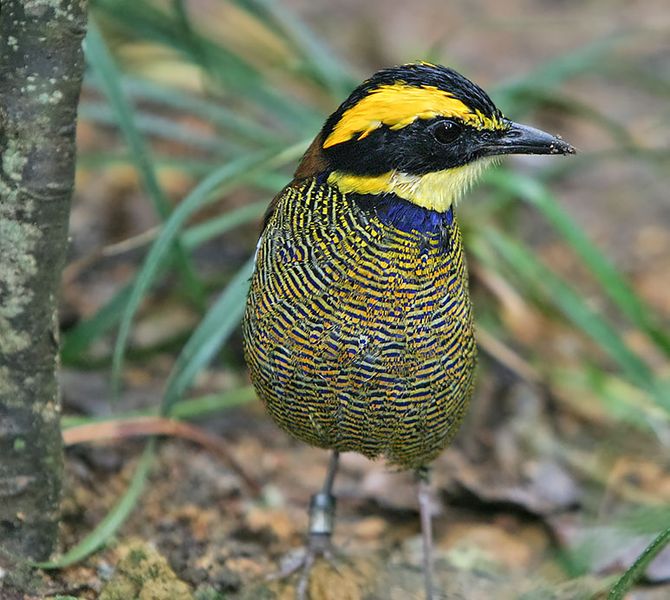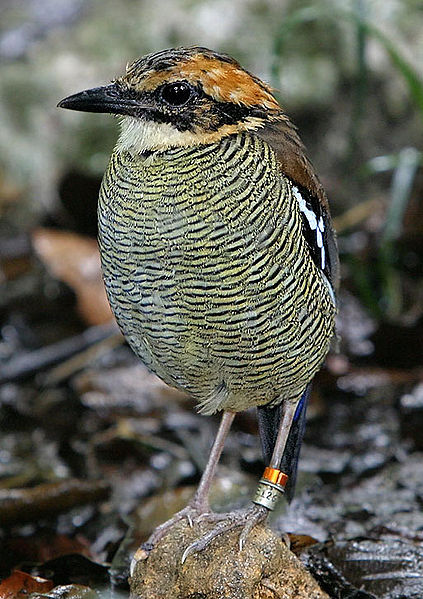 The word “Exquisite” popped into my head when I caught my first glimpse of a Banded or Van den Bock’s Pitta (Pitta guajana) hopping through the underbrush in a Bronx Zoo exhibit. Years later, I had the good fortune to work with this beautiful ground-dweller, and my enthusiasm for them soared. Although still uncommon in captivity, the Banded Pitta is a species worth aspiring to – definitely a bird to keep as a “goal” while honing your skills and expanding your collection.
The word “Exquisite” popped into my head when I caught my first glimpse of a Banded or Van den Bock’s Pitta (Pitta guajana) hopping through the underbrush in a Bronx Zoo exhibit. Years later, I had the good fortune to work with this beautiful ground-dweller, and my enthusiasm for them soared. Although still uncommon in captivity, the Banded Pitta is a species worth aspiring to – definitely a bird to keep as a “goal” while honing your skills and expanding your collection.
Description
Words fail when one tries to describe the Banded Pitta – light and dark blues, orange, red, yellow, black, brown, white and gray all make their appearance in the male’s plumage. Hens, though more somberly clad, are no less attractive.
I was immediately struck by this little bird’s “posture”, or bearing. The legs are set way back on the body, causing the Banded Pitta to appear very much like a minute crane or heron. Although standing only 8 inches tall, a stocky build and “cocky attitude” makes it appear a good deal larger.
Range and Habitat
Banded Pittas occupy a huge range, being found in moist forests from Thailand south through Malaysia and Indonesia to the Greater Sunda Islands. They stay to the underbrush and forest clearings, and forage almost entirely on the ground.
Housing
Pittas are rather delicate captives – I’ve always viewed their care as being similar, in a sense, to that needed by tropical reptiles and amphibians. Naturalistic habitats are essential for success with these shy beauties. A quiet, heavily planted outdoor aviary or bird room are really the only options for captive Banded Pittas.
Banded Pittas spend most of their time on the ground, and fall victim to foot ailments if not kept on a thick layer of peat, dead leaves, sphagnum moss and similar organic materials. Many of the moss-based products designed for use with reptiles and amphibians are ideal. Hard, packed soil will quickly bring them to grief, so attention to soil composition, watering and other “gardening chores” is critical.
Males utilize dead logs as posts from which to survey their territories, and some individuals prefer to roost several feet above-ground at night.
Moisture
 More so than with most other terrestrial birds, moisture levels must be monitored carefully in Banded Pitta aviaries. In the wild, they are always associated with damp habitats, and soon develop skin and foot problems if kept in arid enclosures.
More so than with most other terrestrial birds, moisture levels must be monitored carefully in Banded Pitta aviaries. In the wild, they are always associated with damp habitats, and soon develop skin and foot problems if kept in arid enclosures.
Their “delight” when the aviary is sprayed with a hose usually assures that Pitta owners do not regard this task as a chore!
Diet
Banded Pittas are entirely carnivorous, and here again their captive care seems to parallel that of certain reptiles and amphibians more than it does “typical” pet birds.
A highly varied diet is absolutely essential – they will decline rapidly in condition and expire if a good deal of effort is not put into this aspect of their care. I maintained insect traps to help meet the needs of the Banded Pittas under my care; a Zoo Med Bug Napper should be considered by all Pitta-keepers.
I’ll cover the specifics of Pitta feeding in Part II of this article.
Further Reading
This article by a Pitta-watcher in Bali provides detailed info and some beautiful photos and drawings.
Don’t rely on photos alone – please take a look at this video of a gorgeous male in the wild (Thailand).
Banded Pitta images referenced from wikipedia and originally posted by Doug Janson
 That Bird Blog – Bird Care and History for Pet Birds
That Bird Blog – Bird Care and History for Pet Birds



